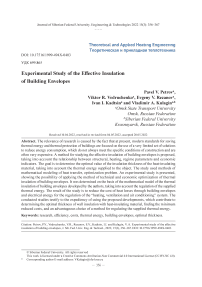Experimental study of the effective insulation of building envelopes
Автор: Petrov Pavel V., Vedruchenko Viktor R., Rezanov Evgeny V., Kadtsin Ivan I., Kulagin Vladimir A.
Журнал: Журнал Сибирского федерального университета. Серия: Техника и технологии @technologies-sfu
Рубрика: Исследования. Проектирование. Опыт эксплуатации
Статья в выпуске: 3 т.15, 2022 года.
Бесплатный доступ
The relevance of research is caused by the fact that at present, modern standards for saving thermal energy and thermal protection of buildings are focused on the use of a very limited set of solutions to reduce energy consumption, which do not always meet the specific conditions of construction and are often very expensive. A method for studying the effective insulation of building envelopes is proposed, taking into account the relationship between structural, heating, regime parameters and economic indicators. The goal is to determine the optimal value of the insulation thickness of the heat-insulating material, taking into account the thermal energy supplied to the object. The study used methods of mathematical modeling of heat transfer, optimization problem. An experimental study is presented, showing the possibility of applying the method of technical and economic optimization of thermal insulation of building envelopes. It was determined on the basis of the mathematical model of the thermal insulation of building envelopes developed by the authors, taking into account the regulation of the supplied thermal energy. The result of the study is to reduce the cost of heat losses through building envelopes and electrical energy for the regulation of the “heating, ventilation and air conditioning” system. The conducted studies testify to the expediency of using the proposed developments, which contribute to determining the optimal thickness of wall insulation with heat-insulating material, finding the minimum reduced costs, and an advantageous choice of a method for regulating the supplied thermal energy.
Research, efficiency, costs, thermal energy, building envelopes, optimal thickness
Короткий адрес: https://sciup.org/146282449
IDR: 146282449 | УДК: 699.865 | DOI: 10.17516/1999-494X-0403
Текст научной статьи Experimental study of the effective insulation of building envelopes
Цитирование: Петров, П. В. Экспериментальное исследование эффективности утепления наружных ограждающих конструкций стен здания / П. В. Петров, В. Р. Ведрученко, Е. В. Резанов, И. И. Кадцин, В. А. Кулагин // Журн. Сиб. федер. ун-та. Техника и технологии, 2022, 15(3). С. 356–367. DOI: 10.17516/1999-494X-0403
-
I. Methods
The “passive experiment” was chosen as the experimental method, which implies the observation and collection of the necessary statistical information about the object under study during its normal operation and comparison with the calculated data.
The duration of the time period during which the experiment was carried out is weekly (daily) and annual cycles.
The study was carried out during an energy audit of a residential complex in the Khanty-Mansiysk Autonomous Okrug – Yugra, the city of Khanty-Mansiysk, together with FSBEI HE OmGUPS and Inkom-Energo LLC. The period of the audit is from 16 to 22 January 2017.
The object accepted for the “passive experiment” is a multifunctional residential building with its own roof-top boiler house, located at Khanty-Mansiysk Autonomous Okrug – Yugra, Khanty-Mansiysk, Gagarin Street, 141. The building was built in 2015, the number of apartments is 77, 100 residents.
Architectural and planning solutions of the building: number of floors – 11; floor height (average) – 3.06 m; heated area of the building – 6929.6 m 2 ; heated volume of the building – 23593.58 m 3 ; wall area – 4073.30 m 2 ; roof area – 845.00 m 2 ; door area – 20.00 m 2 ; window area – 462.00 m 2 ; floor area – 813.00 m 2 .
Functional groups of the building premises: floor below 0.000 – public premises; from the first to the ninth floor – residential and public premises: the tenth floor – utility premises.
Walls: brickwork made of M100 bricks (thermal conductivity 0.44 W/mK) of 500 mm thick; mineral wool insulation (thermal conductivity 0.042 W/mK) of 150 mm thick, lining with cassettes, conditional resistance of the fence to heat transfer 4.86 m 2 °C/W.
Windows: PVC single window unit with double glazing, reduced heat transfer resistance 0.65 m 2 °C/W.
Doors: metal, insulated with mineral wool of 50 mm thick (thermal conductivity 0.042 W/mK), reduced heat transfer resistance 1.4 m 2 °C/W.
Floors: 220 mm thick reinforced concrete slab (thermal conductivity 1.92 W/mK), average reduced heat transfer resistance 2.9 m 2 °C/W.
The heat supply of the building is carried out at the expense of its own roof gas boiler room.
The principal thermal diagram of the rooftop boiler room is shown in Fig. 1, the photo is shown in Fig. 2.
The connection of engineering heating systems of the building to the roof boiler room is carried out according to a dependent scheme.
Estimated temperature curve for regulating the network circuit of the rooftop boiler room 110– 70 °C, the heat carrier in the supply and return pipelines of the hot water supply and heating system of the building, for design conditions 95–70 °C.
The regulation of the heat carrier circulating in the “heating, ventilation and air conditioning” system of the building is carried out in a qualitative and quantitative way (Fig. 3) by changing the temperature and flow rate of the heat carrier, depending on the outdoor air temperature and the temperature of the heat carrier in the return pipeline. To measure the consumption of thermal energy and temperatures, a thermal energy metering unit is provided.
The heating system is two-pipe vertical with top branching.
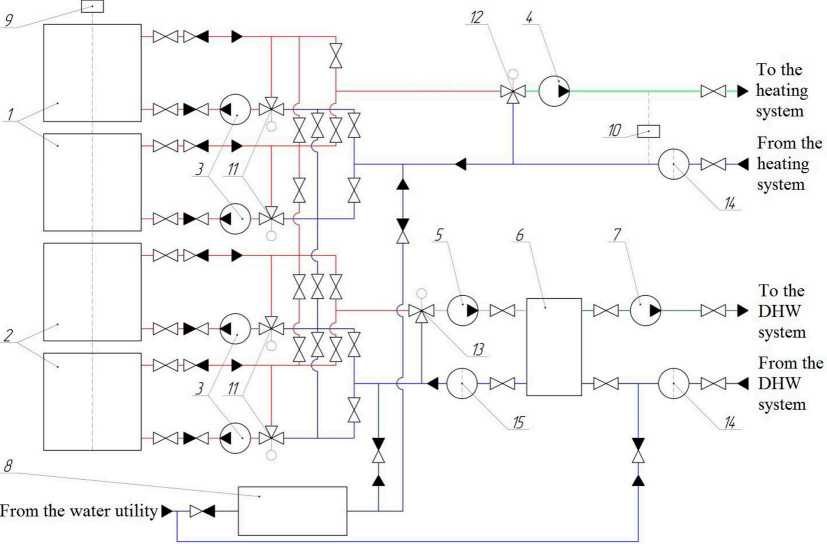
Fig.1. Principal thermal diagram of a rooftop boiler room: 1 – hot water boiler of the heating circuit; 2 – hot water boiler of the hot water supply circuit (DHW); 3 – circulation pump of the boiler circuit; 4 – circulation pump of the “heating, ventilation and air conditioning” system circuit; 5 – circulation pump of the hot water supply system; 6 – hot water heat exchanger; 7 – circulation pump for hot water supply; 8 – water treatment; 9 – gas consumption metering unit; 10 – metering unit for thermal energy of the “heating, ventilation and air conditioning” system; 11 – three-way valve for regulating the water flow of the boiler circuit; 12 – three-way valve for regulating the supply of thermal energy to the “heating, ventilation and air conditioning” system; 13 – three-way valve for regulating the hot water circuit; 14 – mud pan with filter
Bimetal radiators are installed as heating devices in the apartments. Thermostatic and shut-off valves are installed on the connections to heating devices.
Aluminum radiators with thermostatic and shut-off valves are installed in the public areas and the technical floor.
The building is ventilated with a natural impulse. The exhaust ducts of the ventilation system are implemented according to the scheme with satellite ducts connected to the prefabricated exhaust duct under the ceiling of the overlying floor. Exhaust air ducts are made of thin-sheet galvanized steel. There is no air conditioning in the building.
As the measured data of the outdoor climate parameters, the actual average values of the outdoor air temperatures obtained by the operation service using a thermometer were taken and compared with the Gismeteo data (Fig. 4).
The temperature of the indoor air measured with a thermometer from January 16 to January 22, 2017 showed an average of 20 °C for the premises.
Measurement of the daily values of heat consumption in the building (heating) was carried out by the Elf-04n VSTN Du50 heat meter installed in the individual heat substation of the rooftop boiler room. The indication of the electric power of the pumping equipment is carried out by the Smart IMS NP73L.2–5–2 counter.
Table 1. Statistical data on daily changes in building heat consumption
|
Date, dd.mm.yy |
Thermal energy consumption, Gcal/day |
||||||
|
16.01.17 |
17.01.17 |
18.01.17 |
19.01.17 |
20.01.17 |
21.01.17 |
22.01.17 |
|
|
1 |
2 |
3 |
4 |
5 |
6 |
7 |
8 |
|
Value |
4.4 |
3.8 |
4.3 |
4.5 |
5.8 |
3.9 |
7.6 |
УЛ
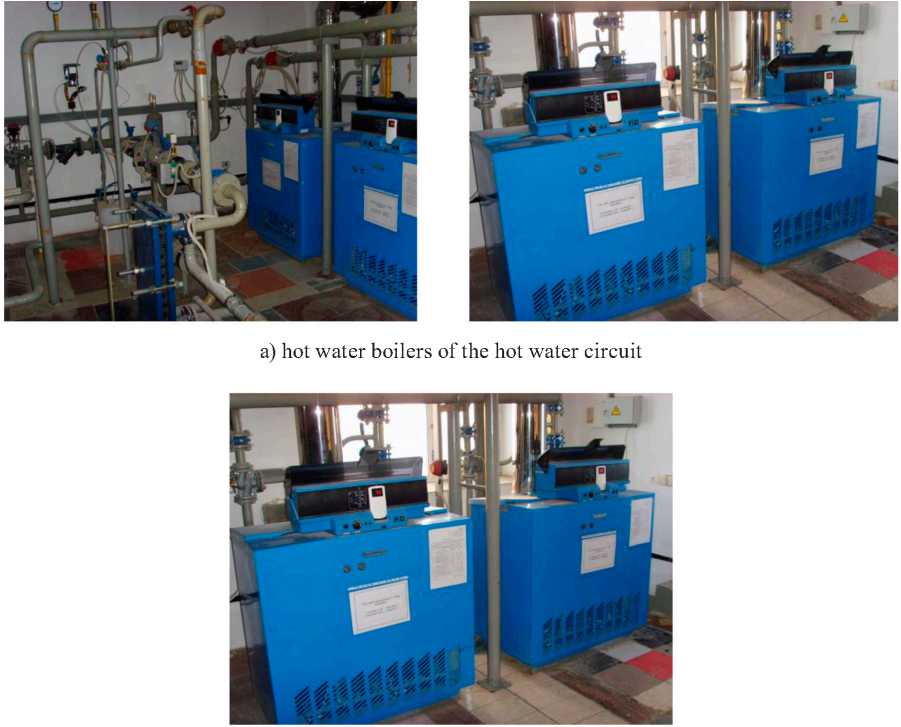
of the hot water circuit
a) hot water boilers
b) hot water boilers of the heating system circuit
Fig. 2. Photos of the roof boiler room
Statistical data on daily and annual (for 2016) changes in the heat consumption of the building were received from the operation service (Table 1).
The actual thermal energy consumption by the building and the electrical energy consumption by the pump system is provided by the operation service for the heating period of 2016 according to metering devices (under actual conditions HSDD=7022.4 °C day, t out = –48 °C, t in =20 °C, t h = –6.6 °C): heat consumption Q act = 726.18 Gcal/year; electrical consumption E act = 7117 kWh/year. Costs for 2016 are shown in Table. 2.
The daily values of heat consumption for heating the building according to architectural and planning solutions, thermal characteristics of enclosing structures and the mode of operation of the premises were calculated and compared with the project documentation.
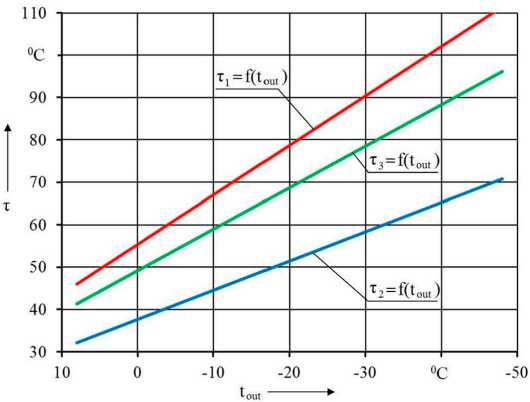
Fig. 3. Temperature chart of qualitative and quantitative regulation
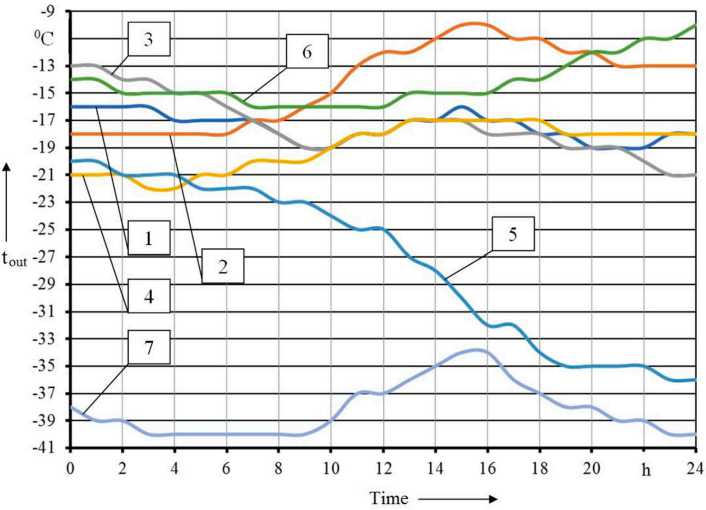
Fig. 4. Changes in outdoor temperatures: 1–16.01.2017; 2–17.01.2017; 3–18.01.2017; 4–19.01.2017; 5–20.01.2017;
6–21.01.2017; 7–22.01.2017
Table 2. Total costs for 2016
|
Ch, rub/J |
C p el, rub/Wh |
Ch, rub/year |
Cel, rub/year |
Ca+C 0, rub/year |
|
1 |
2 |
3 |
4 |
5 |
|
4.287×10–7 |
2.63×10–3 |
1301729 |
18718 |
572700 |
According to the project documentation, the amount of ventilation air exchange in the apartments of a multifunctional residential complex is determined at the rate of 3 m 3 /h per 1 m 2 of the living room area and compensation for the exhaust from the kitchens, bathrooms and toilets. The value of ventilation air exchange in the premises of technical floors was taken in accordance with the standard value. On average, it amounted to (value of ventilation air exchange) η v = 0.65 h -1 .
The value of non-stationary household heat gains in the apartment premises is uncertain. At the same time, this value can have a significant impact on the heat balance of the building and, as a result, on the daily and annual values of heat consumption for heating. To calculate heat consumption for heating, the amount of household heat emissions was taken according to the Russian State Standard SP 50.13330.2012 “Thermal protection of buildings” ( https://files.stroyinf.ru/Data2/1/4293799/4293799306.pdf ).
The measured average values were taken as the initial data for the temperature values of the internal premises and external enclosing structures.
The value of the optimal thickness of thermal insulation can be found based on the minimum of the total reduced discounted costs for the building envelopes I w , by equating to zero the partial derivatives of δ ins function with respect to the optimized parameter, rub/year:
-^ = (86400-zh-Ct +b)-^^ + (Ew + H)-^ = 0, ddjns db^ db^
where δ ins – thickness of the insulating layer of the heat-insulating material of the building envelops, m; z h – the duration of the heating period, days/year; C t – the average annual cost of thermal energy, rub/J; b – a complex of quantities; Q w – heat losses through the outer walls, W; E w – the coefficient of efficiency of investments in thermal insulation of building envelopes, 1/year; H – the rate of deductions in relative units for depreciation and annual maintenance of the building’s heat consumption system, 1/year; Kw – investment in heat-saving measures for insulating the building envelope with thermal insulation, rub.
The solution of equation (1) is represented as:
electrical energy consumption by the transfer pump, rub/W·h; Zp – the duration of the pump operation during the day, h; N pwork – number of working days of pumping equipment per year, 1/year; k – the safety factor; Нp – head developed by the pump, m; γ – the specific gravity of the pumped liquid, N/m 3 ; η tr – transmission efficiency; η р – pump efficiency; ρ l – density of the pumped liquid, kg/m 3 ; C l – the heat capacity of the pumped liquid, J/kg°C; τ3 – the current temperature of the pumped liquid in the supply pipeline of the heating system, °C; τ 2 – the current temperature of the pumped liquid in the return pipeline of the heating system, °C.
-
II. Results
As a result of the calculation, the average daily values of heat consumption for heating the building (with qualitative and quantitative regulation) were obtained for the time period from January 16, 2017 to January 22, 2017 (Table 3).
Calculation of the heat energy consumption by the building for the heating period of 2016, performed on a computer according to the proposed method, with the actual conditions of HSDD=7022.4 °C day, t out = –48 °C, t in =20 °C, t h = –6.6 °C, showed Q calc = 721.83 Gcal/year. The costs are given in Table 4.
To analyze the processes of supplying thermal energy, graphs of qualitative (Fig. 5) and quantitative regulation (Fig. 6), dependences Q w =f(δ ins ) and Q h =f(δ ins ) (Fig. 7), P p =f(δ ins ) were plotted (Fig. 8), as well as the dependence of the reduced discounted costs for the insulation of building envelopes (Fig. 9).
The determination of the reduced discounted costs for the insulation of the outer walls of the building and the optimal value of the thermal insulation thickness calculated on a computer showed (Fig. 9): I wquan = 3161502 rubles / year, δ insopt = 0.159 m with quantitative regulation; I wqual-quan = 3182631 rubles/year, δins opt = 0.16 m with qualitative and quantitative regulation; Iw qual = 3189254 rubles/year, δ insopt = 0.161 m with qualitative regulation.
-
III. Discussion
Comparison of the results of measured (Table 3) and calculated (Table 5) daily values of the building heat consumption shows their sufficient degree of coincidence. An analysis of the change in
Table 3. Calculated data of daily values of building heat consumption
|
Date, dd.mm.yy |
Thermal energy consumption, Gcal/day |
||||||
|
16.01.17 |
17.01.17 |
18.01.17 |
19.01.17 |
20.01.17 |
21.01.17 |
22.01.17 |
|
|
1 |
2 |
3 |
4 |
5 |
6 |
7 |
8 |
|
Value |
4.41 |
3.93 |
4.38 |
4.53 |
5.9 |
3.92 |
7.53 |
Table 4. Total costs for 2016
|
C h , rub/J |
C p el, rub/Wh |
C h , rub/year |
C el , rub/year |
C a +C 0 , rub/year |
|
1 |
2 |
3 |
4 |
5 |
|
4.287×10–7 |
2.63×10–3 |
1293931 |
17346.9 |
572700 |
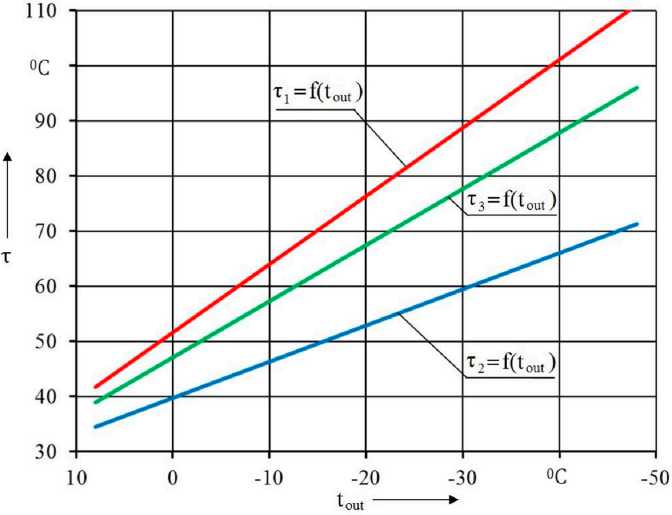
Fig. 5. Qualitative regulation temperature chart
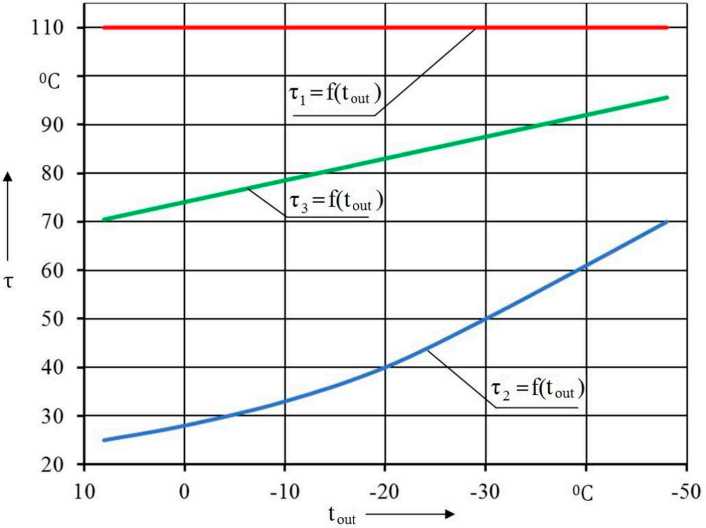
Fig. 6. Quantitative regulation temperature chart the discrepancy showed that the discrepancy between the measured and calculated values does not exceed 2 %.
An analysis of the technical and economic characteristics of the object and the graphs shown in Figures 7–9 shows the convergence of the results’ coincidence in terms of the insulated thickness of the heat-insulating material and costs with given regulation of the thermal energy supply for the base year 2016.
The calculation results (Fig. 9) show that, for the object under study, the most effective process for regulating the supplied thermal energy is “quantitative regulation” (gives savings in the consumption of electrical energy for the drive of pumping equipment).
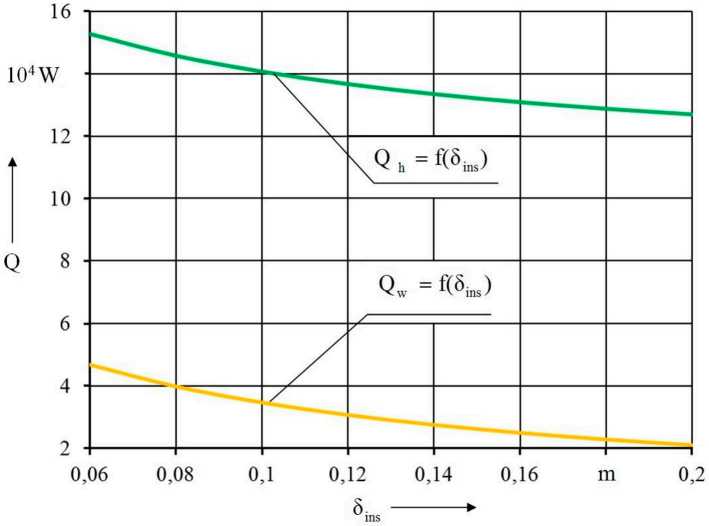
Fig. 7. Dependencies of Qw, Qh on δins
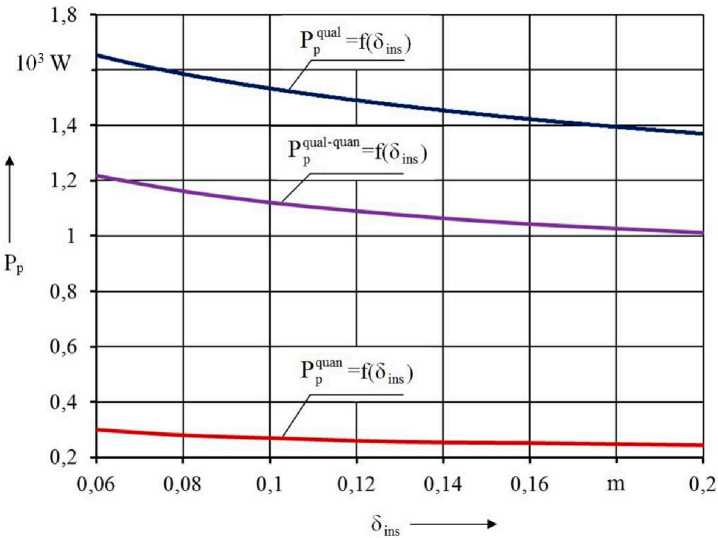
Fig. 8. Dependence of Р p on δ ins : P p qual– average power of pumping equipment with qualitative regulation of the supplied thermal energy, W; Ppqual-quan – average power of pumping equipment with qualitative and quantitative regulation of the supplied thermal energy, W; P p quan – average power of pumping equipment with quantitative regulation of the supplied thermal energy, W
If we take the effective value of thermal insulation of 0.16 m, which is 0.01 m more than already installed (0.15 m), then a difference of 10 mm would reduce heat losses through the building envelope, the consumption of electrical energy and fuel (natural gas) burned in the boiler units of the rooftop boiler room by an average of 2–5 %.
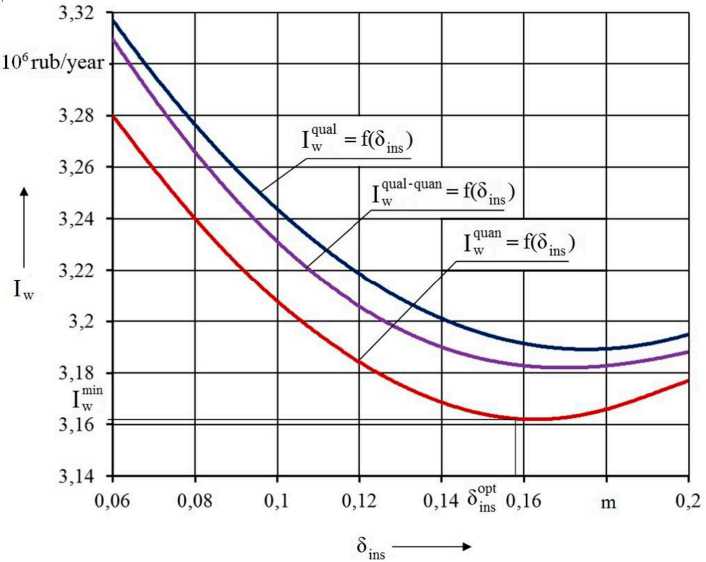
Fig. 9. The dependence of the reduced discounted costs on the thickness of the thermal insulation layer for the building envelopes: Iwqual – the reduced discounted costs for the insulation of the external enclosing structures of walls with the qualitative regulation of the supplied thermal energy, rub/year; Iwqual-quan – reduced discounted costs for thermal insulation of external enclosing structures of walls with qualitative and quantitative regulation of the supplied thermal energy, rub/year; Iwquan – reduced discounted costs for the insulation of the outer enclosing structures of the walls with the quantitative regulation of the supplied thermal energy, rub/year
After analyzing the data of the experiment and calculation, we can conclude that the developed mathematical model and the algorithm “determining the optimal thickness of thermal insulation of the building envelope” are adequate.
Список литературы Experimental study of the effective insulation of building envelopes
- BS EN 15603:2008. Energy performance of buildings. Overall energy use and definition of energy ratings. Effective 2008-09-30. 66.
- Hong, T. et al. Data and analytics to inform energy retrofit of high performance buildings, Applied Energy. 2014. 126. 90-106.
- Crawley, D.B. et al. Contrasting the Capabilities of building energy performance simulation programs: report. United States Department of Energy: University of Strathclyde: University of Wisconsin. 2005. July. 59.
- Hoes, P. et al. User behavior in whole building simulation. Energy and Buildings. 2009. 41. 295-302.
- Fabi, V. et al. Description of occupant behaviour in building energy simulation: state of art and concepts for improvements. 12th Conference of International Building Performance Simulation Association, Sydney, 14-16 November. Proceedings of Building Simulation. 2011. 2882-2889.
- Alajmi, A. Energy audit of an educational building in a hot summer climate. Energy and Buildings. 2012. 47. 122-130.
- Lubina P., Nantka М.Internal heat gains in relation to the dynamics of buildings heat requirements, Architecture civil engineering environment. 2009. 1. 137-142.
- Maile T., Fischer., Bazjanac V. Building energy performance simulation tools. A life-cycle and interoperable perspective: report. Center for Integrated Facility Engineering. 2007. Dec. 43.

